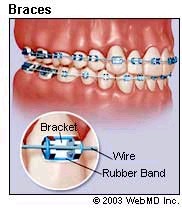|
|
|

How Do I Know if I Need Braces?
First, your dentist will refer you to an orthodontist, a dentist who specializes in correcting irregularities of the teeth. The orthodontist will ask you questions about your health, conduct a clinical exam, gather impressions of your teeth, take photos of your face and teeth, and order X-rays of your mouth and head. An appropriate treatment plan is made based on analysis of the gathered information.
In some cases, a removable retainer will be all that's necessary. In other rare cases (especially when there is an extreme overbite or underbite), surgery may be necessary. In most cases, however, braces will be needed.
What Types of Braces Are Available?

If braces are indeed the solution for you, your orthodontist will prescribe an appliance specific for your needs. The braces may consist of bands, wires, and other fixed or removable corrective appliances.
Generally, there are three types of braces:
Newer "mini-braces," which are much smaller than traditional braces, may be an option for some. Your orthodontist will discuss the various types of available braces with you and determine which might be the best option for you.
What are the Various Parts of Braces and How do They Work?
In their entirety, braces work by applying continuous pressure over a period of time to slowly move teeth in a specific direction. As the teeth move, the bony tooth socket reabsorbs and changes shape as pressure is applied.
Retainers are a custom-made, removable appliance that helps teeth maintain their new position after braces have been removed. Retainers can also be used to treat minor orthodontic problems.
How Long Will I Have to Wear Braces?
The time required for treatment varies from person to person, depending on the severity of the problem; the amount of room available; the distance the teeth must travel; the health of the teeth, gums, and supporting bone; and how closely the patient follows instructions. On average, however, once the braces are put on, they usually remain in place for 1 to 3 years. After braces are removed, most patients will need to wear a retainer all the time for the first 6 months, then only during sleep for many years. In most cases, lifetime wear of retainers is recommended.
How Often Will I Need to See the Orthodontist During Treatment?
Your orthodontist will want to see you about every month or so in order to make sure that the braces are exerting steady pressure on your teeth. To create more tension and pressure on your teeth, your orthodontist will make adjustments in the wires, springs, or rubber bands of your braces. In some cases, braces alone aren't enough to straighten the teeth or shift the jaw. In these situations, an external appliance, such as a headgear may need to be worn at home in the evening or through the night.
Will Braces Cause Pain?
Some of the adjustments your orthodontist may make to your braces may make your mouth feel sore or uncomfortable. When needed, over-the-counter pain relievers like Motrin or Tylenol can help relieve the pain. If you always experience a lot of pain after your braces are adjusted, talk to your orthodontist about it; he or she may be able to make the adjustments a bit differently.
Does the Age at Which I Get Braces Affect the Success of Treatment?
The mechanical process used to move teeth is the same at any age. So the benefits of orthodontic treatments are available to both children and adults who wish to improve their appearance and bite. The main differences between treatments in adults and children is that certain corrections in adults may require more than braces alone and the treatments may take longer because adult bones are no longer growing.
Can I Continue to Play Sports While Wearing Braces?
You can continue to participate in any sport you choose. When playing sports where there is a possibility of getting hit in the mouth, a specially designed mouthguard will need to be worn. The mouthguard, made of durable plastic, is designed to fit comfortably over your braces and will protect the soft tissues inside your mouth.
What Care Can I Expect After the Braces Come Off?
After your braces are taken off, your teeth will be thoroughly cleaned. Your orthodontist may want to take another set of X-rays and bite impressions to check how well the braces straightened your teeth and to see if any wisdom teeth have developed. If wisdom teeth are beginning to come in after your braces have been removed, your orthodontist may recommend the wisdom teeth be pulled to prevent your newly straightened teeth from shifting position in your mouth.
Your orthodontist will also fit you with a retainer (defined above). The use of a retainer is a very important part of post-braces care. Retainers, which are typically made of rubber or clear plastic and metal wires that cover the outside surface of the teeth, need to be worn all the time for the first 6 months and then usually only during sleep. The time frame for wearing a retainer will vary from patient to patient. The reason why a retainer is needed is that even though braces may have successfully straightened your teeth, they are not completely settled in their new position until the bones, gums, and muscles adapt to the change. Also, after long periods of time, teeth tend to shift.
How Much Co Braces Cost?
The cost of braces varies, but you can expect the cost to be between $1,800 and $5,500. Some insurance carriers provide partial coverage for orthodontic treatment while others provide none at all. Check with your insurance provider for the specifics of what your policy covers.
Also see Caring for Teeth with Braces or Retainers.